Molecular Gastronomy 2: Sous-vide Cooking
This is a summary of the second public lecture about molecular gastronomy held at Harvard in the fall of 2010. Some amazing dishes like cigar smoke ice cream, mushroom ice cream with caramel balloon filled with oak smoke and prawns cooked in sherry wine vapor are presented by molecular gastronomy chef Joan Roca.
Sous-vide Cooking: a State of Matter. Speaker: Joan Roca (El Celler de Can Roca in Girona, Spain). The video of the lecture is available on YouTube. The title is a little misleading because this lecture is not really focused on sous-vide cooking but on demonstrating some amazing dishes created by Joan Roca in his restaurant using different concepts. Some of the dishes are cooked using sous-vide though.
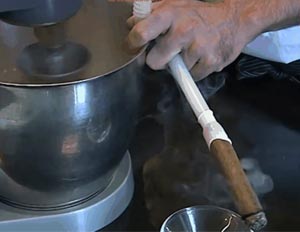 The dishes presented are very interesting and inspiring but the video is really painful to watch. Joan Roca speaks in Catalan and he is being translated by someone who is probably not a professional translator and knows little about cooking. I would just like you to watch a couple of minutes so you really appreciate this post!! Please leave encouraging comments if you like it so I feel better!!
The dishes presented are very interesting and inspiring but the video is really painful to watch. Joan Roca speaks in Catalan and he is being translated by someone who is probably not a professional translator and knows little about cooking. I would just like you to watch a couple of minutes so you really appreciate this post!! Please leave encouraging comments if you like it so I feel better!!
The lecture starts with professors Brenner and Weitz summarizing the main scientific concepts in the lecture. Theme of the week: molecular interactions determine the phase behavior of materials.
Learning objectives of the week:
1- Scientific principles can be used to explain all of the phenomena in cooking; some are complicated and others are not.
2- Understand what phase behavior is and how to read a phase diagram
3- Understand how chefs use phase diagrams to manipulate foods
4- Understand the connection between phase boundaries and microscopic structure of materials.
Uinteraction=3/2 KbT
The professors show and explain that 2D phase diagrams are pressure-temperature charts of a single substance like water or nitrogen. One axis corresponds to pressure and the other to temperature and the lines in the chart represent the phase boundaries between the three phases: solid, liquid and gas. Different materials have different phase diagrams and molecular gastronomy chefs use these to cook each ingredient to perfection. From the phase diagram of water for example, you can conclude that water in a vacuum boils at very low temperature and at high pressure it boils at much higher temperature. This is what happens in a sous-vide machine and a pressure cooker respectively.
Interactions between the molecules in a material determine the phase state of the material. Molecules are stuck together in a solid, as molecules come apart it becomes a liquid and when the temperature increases and they start moving around freely it becomes a gas.
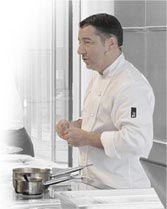
Joan Roca
Silviya Svejenova from ESADE Business School then introduces Joan Roca, head Chef from El Celler of Can Roca, named the 4th restaurant in the world. The restaurant is run by Joan and his two brothers. Joan uses technique in the service of emotions.
Joan Roca first shows images of the restaurant and the city. Then proceeds to explain and demonstrate some of the different concepts they’ve come up with: tradition, cooking with wine, smoke and sweet cooking, and landscape.
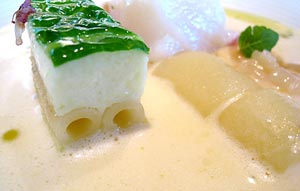 Tradition
Tradition
Joan Roca explains how a traditional soup called “Escabella de Bacalla” is made using new techniques. First, the cod is cooked at very low temperatures 50 ˚C (122 ˚F) for 4 minutes in a vacuum (sous-vide). Then each ingredient is cooked individually to perfection while in the traditional recipe all ingredients are cooked together obtaining the same texture for all of them. The gnocchi are made by replacing the flour with a kind of starch called kuzu that is added to a potato puree. This changes the dish texture, making it really creamy and different. He then adds a macaroon terrine.
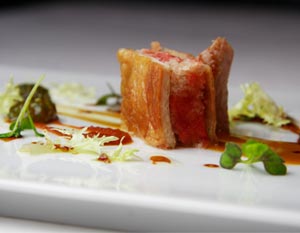 The second dish is based on a traditional dish from Joan Roca's childhood and is a lamb cooked in sous-vide. The skin is then removed and grilled to make it crispy. A bread loaf is rubbed with tomato (very common in Spain) and placed in between two slices of the crispy skin and cut into small squares. Aioli with baked garlic, a compote of tomato and cumin and a broth made with the lamb bones are then added to the plate. The loin of lamb is seared on the grill. The dish is eaten with fingers as he used to do when he was a child.
The second dish is based on a traditional dish from Joan Roca's childhood and is a lamb cooked in sous-vide. The skin is then removed and grilled to make it crispy. A bread loaf is rubbed with tomato (very common in Spain) and placed in between two slices of the crispy skin and cut into small squares. Aioli with baked garlic, a compote of tomato and cumin and a broth made with the lamb bones are then added to the plate. The loin of lamb is seared on the grill. The dish is eaten with fingers as he used to do when he was a child.
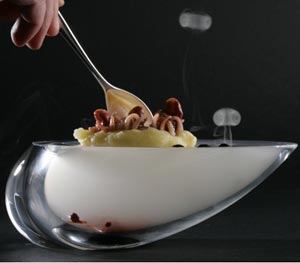 The third dish is based on the traditional “galician-style octopus” but Joan Roca uses a small squid instead of octopus. Mixed pepper paprika from Chile is placed in a glass serving bowl and covered with plastic wrap. A little tiny hole is made on the film. An oblong nigiri shape of mashed potato with olive oil is topped with small squid slices, it is then warmed slightly and topped with grilled squid tentacles. The “niguiri” is then placed on top of the film covering the bowl. A few drops of sauce made with squid ink are added. They then fill the bowl with pipe smoke through the hole in the film. The idea is that every time the diner spoons, puts pressure on the food and on the film and a puff of smoke with paprika aromas comes out of the film hole creating a new sensation of smell and taste.
The third dish is based on the traditional “galician-style octopus” but Joan Roca uses a small squid instead of octopus. Mixed pepper paprika from Chile is placed in a glass serving bowl and covered with plastic wrap. A little tiny hole is made on the film. An oblong nigiri shape of mashed potato with olive oil is topped with small squid slices, it is then warmed slightly and topped with grilled squid tentacles. The “niguiri” is then placed on top of the film covering the bowl. A few drops of sauce made with squid ink are added. They then fill the bowl with pipe smoke through the hole in the film. The idea is that every time the diner spoons, puts pressure on the food and on the film and a puff of smoke with paprika aromas comes out of the film hole creating a new sensation of smell and taste.
Cooking with Wine
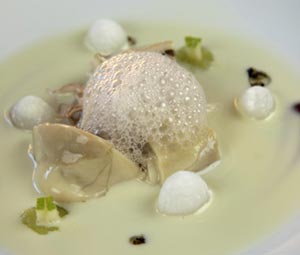 Oysters with Chablis white wine. Joan Roca mixes some acacia honey with Chablis wine to make a syrup. Small drops of the syrup are sprinkled with corn starch and they are then dried for a couple of hours at 100 ˚C (212 ˚F) making the liquor stay in and sugar come out of the drop. After this process they look like the small white pebbles found on the ground of the Bourgogne region in France where Chablis grapes are grown. He then reproduces the aromas from the Chablis wine, the acacia and soil. He uses a distiller machine to boil at low pressure and at very low temperatures 55 ˚C (131 ˚F) preserving the aromas. This earth essence is then converted into a sauce with a little Xanthan Gum. Slices of raw mushroom are placed at the center of the plate with the oyster on top. The dish is finished with oyster sauce, green Granny Smith apple, white truffle oil, fennel cream and air.
Oysters with Chablis white wine. Joan Roca mixes some acacia honey with Chablis wine to make a syrup. Small drops of the syrup are sprinkled with corn starch and they are then dried for a couple of hours at 100 ˚C (212 ˚F) making the liquor stay in and sugar come out of the drop. After this process they look like the small white pebbles found on the ground of the Bourgogne region in France where Chablis grapes are grown. He then reproduces the aromas from the Chablis wine, the acacia and soil. He uses a distiller machine to boil at low pressure and at very low temperatures 55 ˚C (131 ˚F) preserving the aromas. This earth essence is then converted into a sauce with a little Xanthan Gum. Slices of raw mushroom are placed at the center of the plate with the oyster on top. The dish is finished with oyster sauce, green Granny Smith apple, white truffle oil, fennel cream and air.
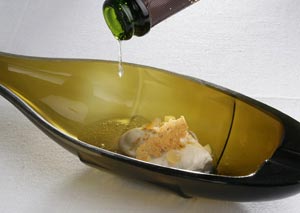 Joan Roca then explains how he modifies cava (Spanish sparkling wine) to create a carbonated cava sauce he calls solid cava. He does this at the winery by introducing Xanthan Gum after the first fermentation of Cava and then let it continue the process for nine months. This results in carbonated cava sauce which he uses in this oyster dish.
Joan Roca then explains how he modifies cava (Spanish sparkling wine) to create a carbonated cava sauce he calls solid cava. He does this at the winery by introducing Xanthan Gum after the first fermentation of Cava and then let it continue the process for nine months. This results in carbonated cava sauce which he uses in this oyster dish.
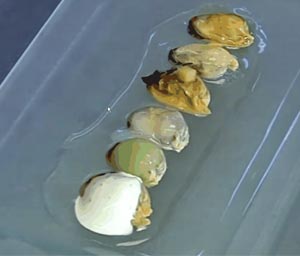 He then presents a dish which is a sequence that represents how the white Riesling wine from Germany evolves when you drink it. He covers the plate with a Riesling wine sauce made using Xanhan Gum, then places 6 mussels and tops them with different ingredients representing the aromas and taste in the order they appear when having a glass of Riesling: bergamot foam, compote of jasmine and apple, cilantro and lemon jelly, roses and nectarine jelly plus caramelized rose petal, distilled earth jelly, white truffle oil.
He then presents a dish which is a sequence that represents how the white Riesling wine from Germany evolves when you drink it. He covers the plate with a Riesling wine sauce made using Xanhan Gum, then places 6 mussels and tops them with different ingredients representing the aromas and taste in the order they appear when having a glass of Riesling: bergamot foam, compote of jasmine and apple, cilantro and lemon jelly, roses and nectarine jelly plus caramelized rose petal, distilled earth jelly, white truffle oil.
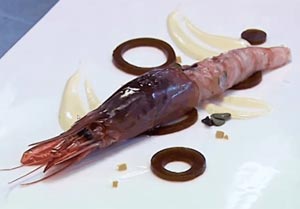 The next dish presented by Joan Roca is prawns cooked in sherry wine vapor. The prawns are layered on a mesh over the wine in a pot and then the pot is covered with plastic wrap. The prawns are cooked lightly in volatile fine aromas of wine. Jelly onion rings are made with a reduction of caramelized onion and broth mixed with agar agar to change the texture and obtain a sheet of gel that is cut into rings. Hazelnut oil and orange skin are added to the dish.
The next dish presented by Joan Roca is prawns cooked in sherry wine vapor. The prawns are layered on a mesh over the wine in a pot and then the pot is covered with plastic wrap. The prawns are cooked lightly in volatile fine aromas of wine. Jelly onion rings are made with a reduction of caramelized onion and broth mixed with agar agar to change the texture and obtain a sheet of gel that is cut into rings. Hazelnut oil and orange skin are added to the dish.
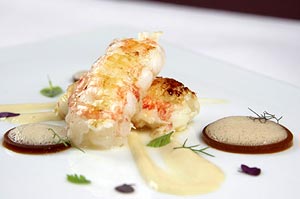 The next dish is also about using aromas when cooking. In this case, using the same technique as before, the wine is replaced with curry to cook little lobsters. The curry toasts in the pan and the lobsters lightly cook with the curry aroma but they will actually have no curry at all. The dish is presented with the same jelly onion rings as before and finished with a veloute sauce made with lobster heads and yolk, foam of Comte cheese, a few flowers and herbs and some drops of walnut oil.
The next dish is also about using aromas when cooking. In this case, using the same technique as before, the wine is replaced with curry to cook little lobsters. The curry toasts in the pan and the lobsters lightly cook with the curry aroma but they will actually have no curry at all. The dish is presented with the same jelly onion rings as before and finished with a veloute sauce made with lobster heads and yolk, foam of Comte cheese, a few flowers and herbs and some drops of walnut oil.
Smoke and Sweet Cooking
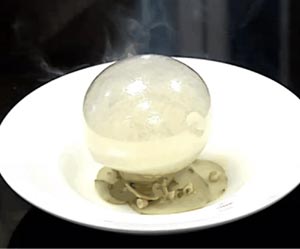 Mushroom ice cream with balloon filled with oak smoke. The balloon is made with caramel using the same technique used to blow glass. Caramel is heated to 150 ˚C, a few drops of citric acid are added to give elasticity to the caramel so it can be manipulated. The caramel is then stretched and folded by hand multiple times. It is then cut with scissors in small pieces and each of them is blown into a balloon with heat and pumping air. The extra caramel on the end attached to the pump is cut by using a hot tube. This creates a hole on that end which will be used to fill the balloon with smoke and as a base for the ball so it stays on the plate. He fills the ball with oak smoke using a pipe and places it on top of the mushroom ice cream. Joan Roca says when you get the smell of the oak, it brings memories and has a comforting aroma.
Mushroom ice cream with balloon filled with oak smoke. The balloon is made with caramel using the same technique used to blow glass. Caramel is heated to 150 ˚C, a few drops of citric acid are added to give elasticity to the caramel so it can be manipulated. The caramel is then stretched and folded by hand multiple times. It is then cut with scissors in small pieces and each of them is blown into a balloon with heat and pumping air. The extra caramel on the end attached to the pump is cut by using a hot tube. This creates a hole on that end which will be used to fill the balloon with smoke and as a base for the ball so it stays on the plate. He fills the ball with oak smoke using a pipe and places it on top of the mushroom ice cream. Joan Roca says when you get the smell of the oak, it brings memories and has a comforting aroma.
 Same caramel technique is used to reproduce fruit. In this case he demonstrates how to reproduce an apricot. The caramel has some orange coloring and when the balloon is still hot he uses a special metal tool to add shape to the apricot. After cooling it with a fan, he spray paints it with raspberry and adds powdered sugar to add the texture. The caramel apricot is then filled with a foam of apricot. The plate is decorated with concentrated coulis of apricot.
Same caramel technique is used to reproduce fruit. In this case he demonstrates how to reproduce an apricot. The caramel has some orange coloring and when the balloon is still hot he uses a special metal tool to add shape to the apricot. After cooling it with a fan, he spray paints it with raspberry and adds powdered sugar to add the texture. The caramel apricot is then filled with a foam of apricot. The plate is decorated with concentrated coulis of apricot.
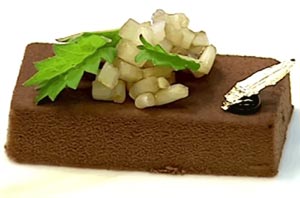 Turron of Foie Gras. This is an example of using techniques from sweet cooking in savory cooking. They’ve applied this technique with yams and beets for example. The turron is a confection, typically made of honey, sugar, and egg white, with toasted almonds or other nuts. In this dish he makes a turron of fois gras. Grilled foie gras is mixed with cocoa butter, hazelnut paste, praline (hazelnut with caramel) and then he introduces air to this emulsion over an ice water bath using an immersion blender. He fills rectangular silicon molds and freezes them. He then spray paints them with chocolate and cocoa butter to form a very thin layer of cacao. A reduction of sweet sherry wine Pedro Jimenez is spread on the plate, the foie gras turron is placed on top and is then topped with soy sprouts in soy sauce. The dish is then finished with a drop of very reduced Pedro Jimenez (sticky syrup) and gold leaf.
Turron of Foie Gras. This is an example of using techniques from sweet cooking in savory cooking. They’ve applied this technique with yams and beets for example. The turron is a confection, typically made of honey, sugar, and egg white, with toasted almonds or other nuts. In this dish he makes a turron of fois gras. Grilled foie gras is mixed with cocoa butter, hazelnut paste, praline (hazelnut with caramel) and then he introduces air to this emulsion over an ice water bath using an immersion blender. He fills rectangular silicon molds and freezes them. He then spray paints them with chocolate and cocoa butter to form a very thin layer of cacao. A reduction of sweet sherry wine Pedro Jimenez is spread on the plate, the foie gras turron is placed on top and is then topped with soy sprouts in soy sauce. The dish is then finished with a drop of very reduced Pedro Jimenez (sticky syrup) and gold leaf.
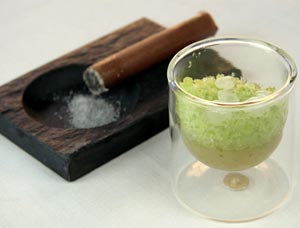 When Joan Roca attended an ice cream course he learned that ice cream absorbs aromas in the air. When he arrived home, he made ice cream while smoking a cigar and the ice cream ended up with cigar aromas. He then wanted to recreate a cigar and this dish was born. A very thin layer of melted chocolate is spread on parchment paper and then rolled and let it cool to make a tube about the size of a cigar. He then mixes an ice cream base while using a device created by them which sucks the smoke from a real cigar and releases it over the whipping ice cream. The chocolate tube is then filled with this ice cream, one end is closed with chocolate and the other end is dipped in black sugar mixed with spices that pair well with tobacco and resemble the ashes. This is served on an ash tray that also contains some of that black sugar mix to resemble the ashes and in which the diners can dip the chocolate cigar. This is paired with a mojito dessert made of rum biscuit, lime soup and mint shaved ice, rum candies like the one done with the Chablis and sugar cane honey.
When Joan Roca attended an ice cream course he learned that ice cream absorbs aromas in the air. When he arrived home, he made ice cream while smoking a cigar and the ice cream ended up with cigar aromas. He then wanted to recreate a cigar and this dish was born. A very thin layer of melted chocolate is spread on parchment paper and then rolled and let it cool to make a tube about the size of a cigar. He then mixes an ice cream base while using a device created by them which sucks the smoke from a real cigar and releases it over the whipping ice cream. The chocolate tube is then filled with this ice cream, one end is closed with chocolate and the other end is dipped in black sugar mixed with spices that pair well with tobacco and resemble the ashes. This is served on an ash tray that also contains some of that black sugar mix to resemble the ashes and in which the diners can dip the chocolate cigar. This is paired with a mojito dessert made of rum biscuit, lime soup and mint shaved ice, rum candies like the one done with the Chablis and sugar cane honey.
Landscape
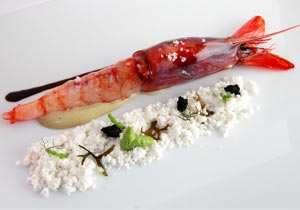 In this prawn dish Joan Roca tries to represent the prawn surroundings. He creates sand with Maltodextrin and oil made from prawn heads. Prawn is grilled on oak BBQ. He uses the rotary evaporator to make broth from the prawn head and reduce it to a thick sauce without high heat to preserve the aromas. He places a line of this reduction on the plate, the grilled prawn and the sand next to it. Over sand they place some seaweed, salicornia (bush that grows on the beach) and meringue that looks like coral reef.
In this prawn dish Joan Roca tries to represent the prawn surroundings. He creates sand with Maltodextrin and oil made from prawn heads. Prawn is grilled on oak BBQ. He uses the rotary evaporator to make broth from the prawn head and reduce it to a thick sauce without high heat to preserve the aromas. He places a line of this reduction on the plate, the grilled prawn and the sand next to it. Over sand they place some seaweed, salicornia (bush that grows on the beach) and meringue that looks like coral reef.
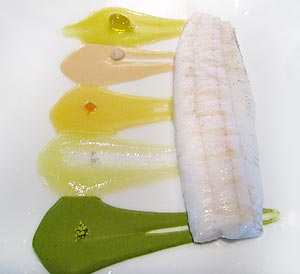 In this dish, Joan Roca debones the sole and reproduces the sole again without the bones. Both pieces are joined with a coagulation of protein, joined together because of pressure of the vaccum, no transglutaminase is used. The sole is immersed in water with 10% salt for 4 min. He then puts both pieces of sole together in vacuum bag and it is cooked at 55 ˚C (131 ˚F) for 4 min. The stick together sole pieces are then finished on the BBQ. This cooking technique allows the sole to be moist and not dry. Cook it with the vacuum and then grill it to get the color and better visual and some charcoal aromas. In this dish he reproduces the colors and flavors of the Mediterranean. For that he uses fennel by extracting the juice from it, adding agar agar to give some consistency and then add olive oil which is absorbed thanks to the high density already obtained. In a similar way he creates 4 other sauces of olives, pine nuts, orange and bergamot. A sequence of 5 sauces is then created on the plate and the cooked sole is placed next to them. On top of the sole he places a matching sequence of olive caramel drop (created by one drop of olive oil on hot caramel), pine nuts, orange peel, bergamot flower, fennel flower, so it matches with each of the 5 sauces on the plate.
In this dish, Joan Roca debones the sole and reproduces the sole again without the bones. Both pieces are joined with a coagulation of protein, joined together because of pressure of the vaccum, no transglutaminase is used. The sole is immersed in water with 10% salt for 4 min. He then puts both pieces of sole together in vacuum bag and it is cooked at 55 ˚C (131 ˚F) for 4 min. The stick together sole pieces are then finished on the BBQ. This cooking technique allows the sole to be moist and not dry. Cook it with the vacuum and then grill it to get the color and better visual and some charcoal aromas. In this dish he reproduces the colors and flavors of the Mediterranean. For that he uses fennel by extracting the juice from it, adding agar agar to give some consistency and then add olive oil which is absorbed thanks to the high density already obtained. In a similar way he creates 4 other sauces of olives, pine nuts, orange and bergamot. A sequence of 5 sauces is then created on the plate and the cooked sole is placed next to them. On top of the sole he places a matching sequence of olive caramel drop (created by one drop of olive oil on hot caramel), pine nuts, orange peel, bergamot flower, fennel flower, so it matches with each of the 5 sauces on the plate.
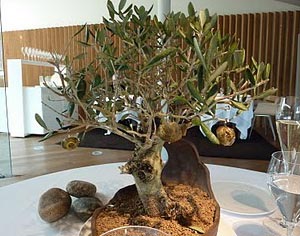 Olive Bonsai. This is the first thing that diners are offered in his restaurant, El Celler de Can Roca, when they arrive. Caramelized olives hanging from an olive tree bonsai. He makes a caramel and when it reaches 150 ˚C (302 ˚F), he removes it from heat, adds dried olives and reduced sherry vinegar. The caramel is then spread between silpats and stretched using rolling pin. He cuts it with knife in squares and then a couple of small pieces are melted in the oven to obtain a very thin layer of this olive caramel. Each olive is rolled with this caramel while it is still hot. They are then served hanging from an olive tree bonsai.
Olive Bonsai. This is the first thing that diners are offered in his restaurant, El Celler de Can Roca, when they arrive. Caramelized olives hanging from an olive tree bonsai. He makes a caramel and when it reaches 150 ˚C (302 ˚F), he removes it from heat, adds dried olives and reduced sherry vinegar. The caramel is then spread between silpats and stretched using rolling pin. He cuts it with knife in squares and then a couple of small pieces are melted in the oven to obtain a very thin layer of this olive caramel. Each olive is rolled with this caramel while it is still hot. They are then served hanging from an olive tree bonsai.
Q&A
Answering a few questions from the audience, Joan Roca states that cooking at low temperatures is only applied when using immediate cooking. When precooking, he uses higher temperatures to kill bacteria and avoid food poisoning. Mainly texture and taste are the main objective of using the right relationship of temperature and time for each product to maintain its quality. When making the aroma of earth, he uses filters in the machine to avoid the bacteria passing through because they work at very low temperature that does not kill bacteria.





